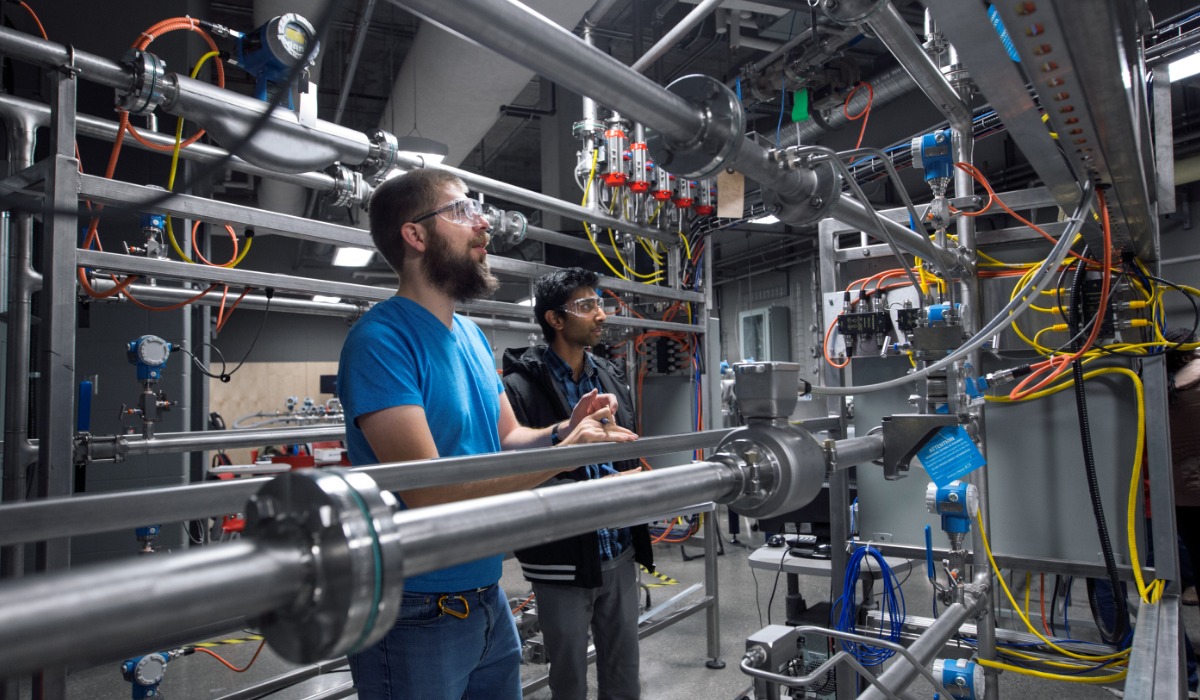Overview
Learn how to install, repair and maintain measuring and control devices used in industrial and commercial processing.
On the job, you’ll refer to manuals to figure out test and maintenance procedures. You’ll work with pneumatic, electronic and microcomputer devices to measure and control pressure, flow, temperature and more.
Additionally, you’ll consult with and advise process operators, repair, maintain and replace defective parts and conduct risk assessments per manufacturers’ specifications.
You’ll also work with engineers to install and maintain instruments and equipment, consulting with them to interpret and apply CSA, ISA, and API installation standards and best practices.
Instrumentation and control technicians are independent and motivated. You’ll succeed in this line of work if you enjoy problem-solving, logical reasoning and being detail-oriented.
To succeed in this trade, you should:
- enjoy math, science and mechanics
- be interested in new technologies
- be comfortable working independently
- be creative and innovative
- enjoy finding solutions to challenges
- take pride in high-quality work
- communicate well with other people
- be committed to maintaining health and safety procedures in the workplace.
Upon successfully completing the required working hours and technical training periods, you'll be awarded an advanced diploma in addition to journeyperson status by Alberta’s Apprenticeship and Industry Training.
This is a Red Seal Endorsed trade — a recognizable standard that allows tradespeople to work across Canada.
Careers and opportunities
Our graduates may work in the following occupations. Some careers require additional experience and education.
Associated National Occupational Classification (NOC) codes: 22301, 22310, 22311, 22312, 22313, 72011.
Apprenticeship training
The term of apprenticeship for instrumentation and control technicians is four years (four 12-month periods), including a minimum of 1560 hours of on-the-job training and eight weeks of classroom instruction at SAIT in the first and second years, and a minimum of 1500 hours of on-the-job training and 10 weeks of classroom instruction at SAIT in the third and fourth years.
Year 1 | Period 1
You'll start by learning standard workplace safety and shop practices. You'll then learn electrical theory and safety, basic measurements and calibration, final control elements as well as related applied physics and calculations.
Training length: 8 weeks
Year 2 | Period 2
You'll learn about measurement instruments, control instruments, electrical and digital fundamentals and process equipment and energy systems.
Training length: 8 weeks
Year 3 | Period 3
You'll learn electronic instrument loops, measurements, physical properties, process analyzers and process control.
Training length: 10 weeks
Year 4 | Period 4
You'll learn advanced process control, communication systems, control systems, process analyzers, maintenance and workplace coaching skills.
Training length: 10 weeks
Apprenticeship education performance
You must pass each section of the course and the AIT exam to succeed in apprenticeship education.
The passing grade for each period is no less than 50% in each course, with no less than a 65% average overall. A passing mark on each provincial exam and the interprovincial qualification (Red Seal Exam) is 70%.
View Alberta's Apprenticeship and Industry Training procedures
Training pathways
You can earn your journeyperson designation in the following way.
The traditional training pathway begins with finding a job with an employer willing to indenture you as an apprentice. Once you are an apprentice, you'll alternate between on-the-job training and educational periods.
You must apply for an apprenticeship through Alberta Apprenticeship and Industry Training before attending your first education period at SAIT.
SAIT’s two-year Instrumentation Engineering Technology diploma program equips you with the necessary skills and knowledge to successfully challenge the Alberta Apprenticeship and Industry Training (AIT) exams for Instrumentation and Control Technician periods one through four as well as the Journeyperson apprenticeship exam.
Admission requirements
To enter an apprenticeship, you must have the educational qualifications required or recommended education for the trade to which you apply.
Entrance requirements are monitored and set by Alberta Apprenticeship and Industry Training.
Minimum requirements
Successful completion of the following courses:
- English 20-2
- Math 30-3
- Physics 30 and Chemistry 30
OR
A pass mark in all five Canadian General Educational Development (GED) tests
OR
Alberta Apprenticeship and Industry Training Entrance Exam
MyTradeSecrets
Once you have begun working as an apprentice, you can attend SAIT to complete your technical training.
You'll register for technical training at SAIT on MyTradeSecrets or you can register by phone.
Transfer agreements
At SAIT, we have created transfer agreements with partner institutions to allow you to earn course credits toward your SAIT program based on your previously completed credentials.
Transfer Alberta search tool
Use the Transfer Alberta search tool to see all transfer agreements between Alberta post-secondary institutions (including those with the University of Calgary, Mount Royal University and Bow Valley College.)
Search transfer agreements in Alberta
Transfer options for graduates
When you have completed this program, you may continue your education at a partner post-secondary institution. These transfer agreements include partnerships within and/or outside of Canada.
Credits this program transfers to
- Available credits:
- 57
- Available credits:
- 60
Available intakes
Costs
2025/26 tuition and fees
The following costs are effective as of July 1, 2025.
This is a bring-your-own-device program with standard computer hardware and software requirements. See the specific requirements on our computers and laptops page.
Books or modules, along with other items for classes, are approximately $600 per period.
We recommend you don't purchase books or modules ahead of time as they might be outdated by the time you attend classes, and they cannot be returned to the Bookstore.
Personal protective equipment (PPE) will be required for the program, which may be an additional cost to apprentices.
Funding options for apprentices
Apprentices get to learn while they earn, but there are still costs to consider. Many resources are available at SAIT and federally to help support apprentices.
Information sessions
Prepare for a strong start in your chosen program or get the details you need to decide your future path.
Our expert staff and faculty are ready to answer your questions and provide information about the following:
- What sets SAIT apart
- An introduction to the program and area of study
- Admission requirements
- Future career paths
- Information on the earning potential and graduate employment rates.
Contact
Have more questions?
Apprenticeship training and registration
Apprenticeship and Industry Training Client Services

Oki, Âba wathtech, Danit'ada, Tawnshi, Hello.
SAIT is located on the traditional territories of the Niitsitapi (Blackfoot) and the people of Treaty 7 which includes the Siksika, the Piikani, the Kainai, the Tsuut’ina and the Îyârhe Nakoda of Bearspaw, Chiniki and Goodstoney.
We are situated in an area the Blackfoot tribes traditionally called Moh’kinsstis, where the Bow River meets the Elbow River. We now call it the city of Calgary, which is also home to the Métis Nation of Alberta.
